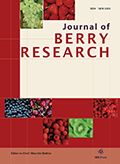Authors: Qaderi, Rohullah | Mazzoni, Luca | Tonanni, Virginia | Gagliardi, Francesco | Capriotti, Luca | Pergolotti, Valeria | Diaz, Yasmany Armas | Capocasa, Franco | Mezzetti, Bruno
Article Type:
Research Article
Abstract:
BACKGROUND: Strawberries are a delicate, high nutritional value fruit with an extremely short shelf life and high susceptibility to tissue infection, mainly by Botrytis cinerea . Control of the disease requires an extensive amount of fungicide that is applied in varying complexes because the pathogen easily develops resistance against the active compounds. Planting tolerant cultivars seems to be a promising alternative for fruit growers, but there are currently no cultivars available combining tolerance to B. cinerea with attractive horticultural traits. OBJECTIVE: In this study, four well-defined strawberry cultivars (‘Romina’, ‘Cristina’, ‘Silvia’, and ‘Sibilla’) were selected and tested
…under treatment with Botrytis cinerea to determine the tolerance of each cultivar and its association with fruit quality. METHODS: Fruits were harvested and then stored for four days after inoculation (treatment) or not (control) with spores of B. cinerea ; then, every day the level of decay was detected, and fruits were frozen for successive evaluation of fruit quality. RESULTS: The ‘Silvia’ cultivar is the one that demonstrated a higher level of tolerance to Botrytis infection during the treatment, and the ‘Romina’ cultivar was the cultivar most susceptible to the treatment. The results of the study also highlighted qualitative changes in all strawberry cultivars infected with Botrytis cinerea , by a decrease in the soluble solids content and an increase of acids. Generally, in all cultivars, phenolic acids, and vitamin C decreased in both control and infected but there was a strong decrease in infected fruit compared to control. Anthocyanin content increased in control fruits but strongly decreased in infected. CONCLUSION: As a preliminary outcome, a positive correlation was obtained between fruit nutritional quality and tolerance to decay, as a high amount of nutritional compound content provides lower susceptibility of fruits to Botrytis cinerea . To confirm this result more studies need to be done.
Show more
Keywords: Anthocyanins, postharvest, polyphenols, vitamin C, soluble solids
DOI: 10.3233/JBR-230050
Citation: Journal of Berry Research,
vol. 14, no. 2, pp. 89-103, 2024
Price: EUR 27.50





